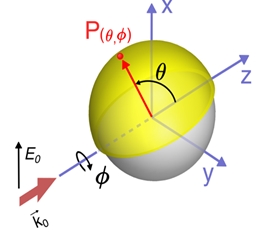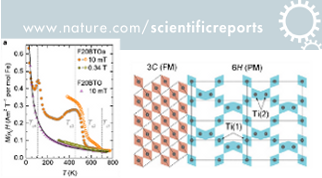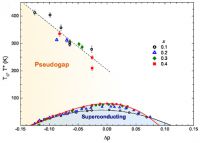Department of Physics
Faculty of Science
University of Zagreb
Bijenička c. 32
10000 Zagreb, Croatia

We point out that the momentum distribution is not a proper observable for a system of anyons in two dimensions. The quasimomentum distribution can be used to identify anyonic statistics in standard time-of-flight measurements.

We theoretically show that tailoring the topology of the phase space of the light particle interaction is a fundamentally more versatile approach, enabling dynamics that may not be achievable by shaping of the light alone.
Science Advances 3 (6), e1602738 (2017)

A new hetero-tetranuclear compound [Cr2(bpy)4(μ-O)4Nb2(C2O4)4]·3H2O exhibits an anti-ferromagnetic ground state, coming from two CrIII ions interacting through two −O−NbV−O− diamagnetic bridges, as revealed from magnetization modeling and confirmed by EPR spectra and DFT calculations.
Inorg. Chem.,56 (12), 6879 (2017)

Here we present the first observation of strangeness enhancement in high-multiplicity proton–proton collisions. We find that the integrated yields of strange and multi-strange particles, relative to pions, increases significantly with the event charged-particle multiplicity.
Nature Physics, doi: 10.1038/nphys4111 (2017)

A paper in Scientific Reports 5, 14761 (2015) presents for the first time measurement of the hyperfine magnetic field in magnetic material based on carbon.

We have shown that plasmons in graphene facilitate extremely strong nonlinear optical interactions, even at the few-quantum level.
Phys. Rev. Lett. 114, 236801 (2015)

Here we develop a physical model that describes how kinesin-8 motors affect nuclear centering by promoting a microtubule catastrophe.
Phys. Rev. Lett. 114, 078103 (2015)

Diluted magnetic semiconductors possessing intrinsic static magnetism at high temperatures represent a promising class of multifunctional materials with high application potential in spintronics and magneto-optics.
Nature Scientific Reports 5, 7703 (2015)

A novel heterometallic oxalate-based compound, made of a 3D anionic network is used as a single-source precursor for preparation of the mixed-metal oxide CoMn2O4 through its thermal decomposition.

We consider dc-electronic transport through a nanowire suspended between two normal-metal leads in the presence of an external magnetic field.

The integral cross section of the 12C(n,p)12B reaction has been determined for the first time in the neutron energy range from threshold to several GeV at the n_TOF facility at CERN.
Phys. Rev. C 90, 021601 (2014)

We report systematic 17O-NMR measurements on the high-Tc cuprate (CaxLa1−x)(Ba1.75−xLa0.25+x)Cu3Oy.
Phys. Rev. B 90, 054508 (2014)

We theoretically predict synthetic Lorentz force for classical (cold) atomic gases, which is based on the Doppler effect and radiation pressure.
Phys. Rev. A 89, 063415 (2014)
|
The Department of Physics, Faculty of Science, University of Zagreb is the leading regional center for scientific research and university-level educational program in the field of physics. Employees of the Department of Physics are conducting internationally relevant and competitive research; they participate as project leaders or researchers on the competitive national and international research projects, thus contributing to the higher education in the field of physics at the University of Zagreb. |
In 2017/2018 there are 502 students enrolled in 6 programmes of the integral undergraduate and graduate study of physics (research physics, educational physics, educational physics and computer science, educational physics and technology, educational physics and chemistry, educational mathematics and physics) and 174 students in doctoral study. The current academic staff of the Department consist of 56 teachers and 50 lecturers, assistans or students in the postgraduate doctoral study in physics. |
|
Department of Physics promote scientific excellence through participation at internationally relevant and competitive researches - both basic and applied ones. Develop innovative educational programs based on research and the latest scientific discoveries. Participate in the European Research Area with Croatian researchers and students as equal participants. |
Departmental teaching facilities include 2 lecture halls, 4 medium classrooms, library with reading rooms, 2 computer labs, 7 student laboratory classrooms, 3 seminar rooms, workshop and a dozen of advanced research laboratories. Central Library for Physics has more than 15,000 books and 500 journals. Scientific collection has few thousands of devices and books. |
|
Experimental Physics Division has particular interest in experimental solid state physics, atomic and molecular physics, nuclear physics, and physics of medium and high energy, astrophysics, biophysics and methodology of educational physics.
Beginnings of university-level teaching of physics in Zagreb reaches back to 17th century. The first professor was Stjepan Glavač (1627-1680), and Physics was lectured for the first time in 1664. The teaching of physics continued in the same intensity even after 1669 when the Jesuit Academy in Zagreb has obtained the rights and privileges as a University. |
Theoretical Physics Division is Croatia's flagship research center in the field of theoretical physics, in particular in atomic and nuclear physics, optics and photonics, physics of condensed matter, and biophysics. Members of the Division publish their frontier research work in leading international scientific journals and lead a number of competitive research projects and agreements on international scientific cooperation.
Theoretical Physics Division of Particles and Fields covers research subjects Gravitation and black holes and Phenomenology of elementary particles and fields. Research projects are Graparion - Gravity and parity violation and MIAU - Matter and Interactions at Accelerators and in Universe. |
The European Commission will award €260 million to 1,249 researchers as part of the MSCA Postdoctoral Fellowship 2023 call. The success rate for this year stands at 15.8%, and the selected projects span various disciplines, including social sciences and humanities (25.2%), life sciences (21.7%), information sciences and engineering (13.3%), chemistry (14.4%), and physics (11.4%). Selected applicants represent nearly 80 nationalities and will work in 45 countries in Europe and the rest of the world. Around 150 projects were funded in the field of physics, and three of them were proposed by researchers of the Division of Theoretical Physics of the University of Zagreb.
Dr. Petar Marević, in collaboration with Professor Tamara Nikšić, will conduct the AMPLIFI project in the field of fission. Nuclear fission is the process of splitting the atomic nucleus into two or more rotating fragments, accompanied by the release of a substantial amount of energy. The rotation of fragments has important implications in various branches of basic and applied science, from simulating astrophysical processes to describing events in nuclear reactors. The project aims to enhance the understanding of this phenomenon by leveraging theoretical modeling and supercomputing capabilities.
This year's call, through the budget of the Widening participation and strengthening of the European research area and the associated ERA scholarships, provided the possibility of additional funding for 50 excellent scientific project proposals. Dr. Shane Amadeus Fiorenza was awarded funding to carry out the TRIPOLES project under the mentorship of Professor Nenad Pavin. In this project, he will explore the physical mechanisms of multipolar mitotic spindles, an aberrant architecture found in cancer cells. He will calculate how constituent components of the mitotic spindle work together to produce healthy bipolar spindles and investigate under which conditions they lead to unhealthy tripolar spindles. This project will uncover the physical mechanisms responsible for the stability of multipolar spindles and how their structure transforms during cell division.
These two projects represent the only funded projects of incoming mobility at any of the Croatian institutions. As part of outgoing mobility, Dr. Bhoomika Maheshwari, currently a postdoctoral researcher at the Division, was awarded funding for the implementation of the ISOON project with Professor Pieter Van Isacker at GANIL, France. The project delves into the science of nuclear isomers, complex quantum states with distinct energy levels and long lifetimes. Nuclear isomers hold untapped potential in nuclear physics and astrophysics, capable of revolutionizing energy production, impacting stellar evolution, enhancing timekeeping, and transforming medical imaging. With the global interest in isomer research growing, the project aims for a better theoretical understanding of the description of isomers and their various structural properties, leading to the synergy between theoretical insights and experimental data.
More information is available at https://marie-sklodowska-curie-actions.ec.europa.eu/news/marie-sklodowska-curie-actions-award-eu260-million-to-postdoctoral-researchers-in-2023